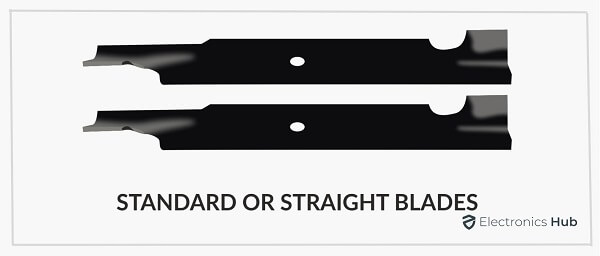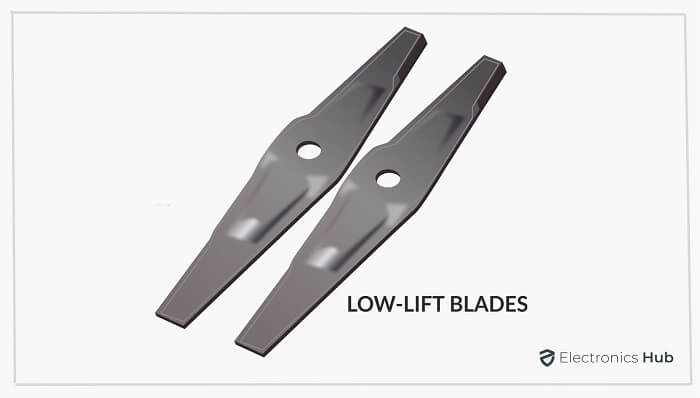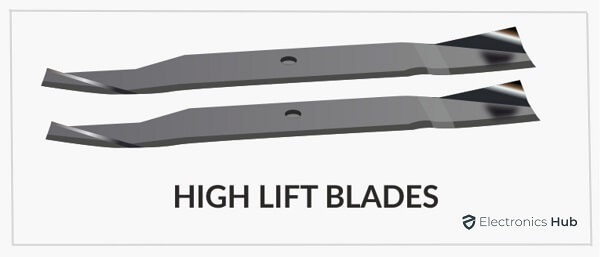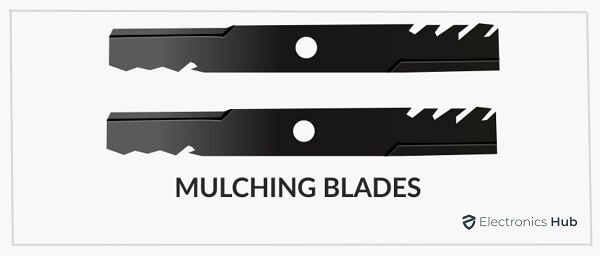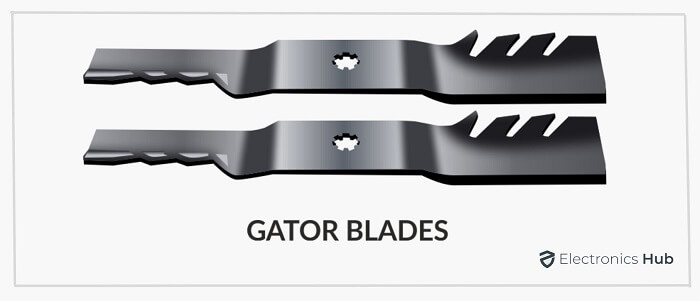The blades are the most essential part of a lawn mower as it is responsible for cutting the grass efficiently and accurately.
A wrong choice can lead to irregular cuttings which ruin the look of your landscape. If you are wondering whether all the blades are same then you are wrong.
Lawn mower blades come in different types, choosing the right one among them is quite challenging, especially if you don’t understand the differences.
We have created this guide to help people make an informed decision while purchasing lawn mower blades. In this article, you can see in-depth differences between lawn mower blade types
Outline
ToggleTypes of Lawn Mower Blades
- Straight Blades
- Low-Lift Blades
- High-Lift Blades
- Mulching Blades
- Gator Blades
In-depth Description of Each Lawn Mower Blade
Below is a clear analysis and description of each law mower blade along with its merits and drawbacks. Read the information thoroughly to understand which one suits your lawn mower better.
1. Standard or Straight Blades
They are known as medium-lift or standard mower blades. They are commonly found on regular lawnmowers, or ones that spin horizontally. Lawnmowers that release debris from the side are often fitted with this mower blade type. Though they’re referred to as straight blades, these generally have a small curvature on the ends.
A reason behind the small curve along edge is that it helps create an uninterrupted flow of air when the blade turns and creates an action of cutting and sucking. Suction is created by the soil that pulls grass up and allows for accurate cut. But straight blades produce a small amount of suction because their edges are inclined. This leads to a tiny quantity of air moving across blade.
Before deciding on blade type, be aware of the kind of lawn you will be cutting. While many people choose straight blades because of their superior efficiency on dry and damp surfaces however, they’re only suitable for areas with large grass patches. The advantage of these blades is swiftly cutting the grass that is dense, and send it to the bagging process effortlessly.
However, one of the disadvantages of the blades might not be capable of cutting through smaller bunches of grass, which could result in a sloppy cutting process. In this regard it is recommended to choose a different type of blade in the event that your yard is shady areas of grass. Another disadvantage of straight blades is the small suction power which cannot be sufficient to push grass debris out of the bag. This could create a blockage within chute.
Benefits of Standard Lawnmower Blades
- The slightly curled ends aid in suction.
- It can cut through thick grass patches easily.
- Ideal for all kinds of soil.
- Cuts both dry and damp surfaces with great efficiency.
Drawbacks of Standard Lawnmower Blades
- The tendency to blockage in chute and restricts storage space in bag.
- Might not be capable of cutting small clumps creating uneven lawns.
2. Low-Lift Blades
They are designed to mowing soil that is sandy due to low suction capacity. The blades’ edges are also less curly than standard ones.
The suction is low, which doesn’t allow grass to get up too high. This keeps the grass well-anchored for cutting and then discharged to the side. In the same way, this doesn’t allow dust to pick up with it. Therefore, it settles on ground without being blown around in the air that you breathe.
The blades that are low-lift are typically about 3-4 inches long and demand less energy for the engine of your lawnmowers. Because they don’t burden the engine to much it is given a longer life span.
Blades that have more suction will deteriorate more quickly than blades that have low lift. The dust can settle into the deck, causing blades to wear away prior to the expiration date they were originally scheduled for.
Thus, if you depend on durability over time, blades with this type of design are a suitable choice. Blades with low lift are also suited because of their capacity to operate quietly. They don’t produce much noise since they don’t require any power to work effectively.
Benefits of low-lift Blades
- Needs more power for function
- Ensures effective yet silent mowing
- Perfect for mowing sandy terrains
- Comes with durability and longevity
Drawbacks of low-lift Blades
- Not capable of sucking debris into a bag
3. The High Lift Blades
It is easy to distinguish High-lift blades from their distinct vertical angles along the edges. This allows for maximum airflow through the blades and results in a suction vertical like none other.
The rapid circular movement of the blades keeps the grass straight in preparation for the accurate trimming. It lets you cut your lawn with more accuracy and give it a clean and clean look.
High-lift blades are available from the length between 1 – 21 inches and are suitable to yards that have tall grass. The suction force is strong and ensures that there isn’t an accumulation of grass inside the chute, thereby preventing obstruction. This is why people who like bagging tend to lean toward such blades.
However, this feature renders it unsuitable for mowing on sand-covered terrains. Due to the high flow of air through the mower, it is possible that blades can be prone to pull in sand and dust as well as the grass.
As we all know dust may settle on the mower’s deck. This can cause it to wear away in a short time. In addition, the quick and continuous rotation of the blades requires more power to generate more suction. Additionally, this could lead to damage to the lawn mower sooner than anticipated.
Benefits of high-lift Blades
- Provides elegant finish
- Capable of sucking out and storing the leftover remains
- Perfect for clipping tall-grass clippings
Drawbacks of high-lift Blades
- The power drains out quickly
- Not suitable for using on sandy soil conditions
- They wear out quickly
4. Mulching Blades
They are also called a multi-purpose blade. They have a curved surface which permits it to work in different ways. The blade first raises grass and precisely cuts it into pieces. The cuttings or clippings will be taken towards the deck, which is where they will be cut into small pieces. Then, the inside curvature of blade generates the pressure of air that blows away the tiny pieces of clippings.
You can use them to fertilize the soil. Finer grass fragments are better as they will absorb nutrients by the soil.
The sharper and more curvier edges, along with cutting edges generally let mulching blades chop grass in smaller bits and then to expel them back into the ground. While mulching blades create lesser suction but lift the tall grass and straighten them enough to cut it.
If you’re looking the lawn to appear beautiful and also help to fertilize your landscape parallelly using mulching blade, it’s the perfect choice. Indeed, it is the best way to get rid of mowing debris that is not needed anymore.
Benefits of Mulching Blades
- Can work for different purposes at same time
- Comes with numerous curves which allow accurate cutting
- Ensures soil enrichment
- Perfect when you are not clearing clippings
Drawbacks of Mulching Blades
- Cutting dense grass can lead to blockage or clogging
- Has low suction which can make it unfit for cutting dense and tall grass
5. Gator Blades
Just like mulching blades similar to mulching blades, blades of gator are ideal to fertilize the soil. In reality the gator blades have been modified to accomplish the job more effectively.
The blades are specifically designed to generate maximum suction over the grass, pulling it upwards. This is due to an exact angle of those teeth on the mulching blade. It is an inferior blade that pulls grass upwards so that the grass will be cut with precision.
Unique angle that the gator’s teeth have will push the grass towards its sharp edge while the mower moves. This allows smaller grass pieces to cut again and again. It is possible to cut tall grasses into small pieces using this blade with ease.
To maximize the benefits of this method, put a mulching tool on the blade. The mulching kit can help spread the fine pieces grass so that they settle on the soil in a uniform way.
Finely cut grass adds essential fertilizers to soil. This will greatly increase the yield when you’re trying to plant fruit and flowers in your backyard.
It is also possible to collect all of the pieces that have been chopped into the grass collector bag. This can save you your time as well as effort taking care of the yard. It also helps in making your garden look attractive. Therefore, you’ll benefit by both sides.
Benefits of Gator Blades
- Curved teeth lift the grass upwards
- Suitable for fertilizing soil
- Ideal for mulching leaves
- Precise cutting job
Drawbacks of Gator Blades
- Not for regions with sandy soil
- The edges will become dull quickly
Some Frequently Asked Questions
No, not all lawn mower blades are the same. Each type of lawn mower has its own specific blade type that is designed to work best with that particular mower. For example, a riding lawn mower will have a different blade than a push lawn mower. The blade on a riding lawn mower is designed to be able to cut through thicker grass and will be much sharper than a push lawn mower blade.
is the best way to locate replacement lawn mower blades. The OEM number refers to the manufacturer’s numerical part number for the blade. Most cases, you will only need to enter this number and the manufacturer name into an online search engine or store to get some promising results.
The length of the mower blade and the center hole size are the two most important factors to consider when buying lawn mower blades. If your mower requires it, make sure to get a blade that has the correct outer holes. If you’re mowing cool-season grasses, use high-lift blades.
The great thing about it is that many standard lawnmowers are capable of being modified for mulching. For best results, it is important to follow the steps below: Install a suitable mulching mower blade; and. You will also need to install a restriction plate.
If your grass tips are becoming ragged and brown, you will know it is time to sharpen your lawn mower blades. This can cause your grass to lose its ability to store water and make it more susceptible for disease. Some manuals for lawn mowers recommend sharpening or changing blades every 25 hours.
Some people believe that replacement blades should not be sharpened until they are used. This is because of the powder-coated finish that is applied by the manufacturer to most blades. This coating is thicker around the blade’s cutting edge, and can feel dull to the touch.
A good rule of thumb for homeowners is to replace their mower blades every year. Regularly sharpening your mower blades will extend the life of your blades. If you decide to sharpen your mower blades at home, make sure you wear protective gear and disconnect spark plugs.
A dull lawnmower blade can cause your lawn to look yellow, brown or raggedy. A dull lawnmower blade can pull up parts of your grass, as it pulls on the whole plant rather than cutting through the grass blades cleanly.
A new, sharp blade will give you a clean, neat shave. Your grass will experience the same effect. Sharp cutting blades make your lawn look great, and keep it healthy. The mower blades that are too dull or damaged can cause a bruising to the edge of your grass blade. This will leave a ragged end and not a clean cut.
Most mower blades will last 100 to 200 hours in normal conditions. If you purchase high-quality blades, the number of hours could be up to 400. You can use a grinder or a metallic file to sharpen your blades if they become dull. However, this will only work for about 2 to 3 times.
Mower blades today are made of low-carbon alloy steel. Most of the latest mower blades are rigid in nature but softening makes them bendable if they strike a rock or piece of wood. Because these blades are designed for being soft, it makes lawn mowing safer.
The blades made from a harder steel alloy do not bend, but instead break. This can lead to steel bits flying around, especially when the blades spin at very high RPMs.
Design-wise, almost all of the lawnmower blades are interchangeable between single-blade and multi-blade lawnmowers. The dimensions of the blades are the only thing that will vary. Multi-blade mowers require that the blades overlap slightly to achieve consistent and clean cuts.
This means that the two-blade mower blades may be slightly shorter than the single-blade blades. If the lawnmower mounts and blade match, the different types of lawnmower blades can be interchanged.
The best one for you depends on your personal preferences and lawn conditions. Depending on what type of mower you use, certain blades might perform poorly. A mulching blade, for example, can be attached to a regular mower. However, it must be equipped with additional accessories to ensure that it does a good job of mulching.
Mower blades may vary in their dimensions, shape, and type of mounts. These are important details when it comes to lawnmower blades. Not all blades will fit into every lawnmower.
The blades’ diagonal length can range from 6 to 32 inches. The width of the slit can vary from 1.5 to 4.25 inches. The blade’s thickness can vary from 0.01 to 0.33 inches.
There are two options for the number of holes in the blade: one or three. They can also come in different shapes. Blades with two outer holes may require a blade adapter. A blade with only one center hole will work fine.
Few Words to Wrap Up…
The efficiency and quality of cutting depends mostly of the blades of lawn mower blades. Having a wrong blade can mess the look of your beautiful landscape. To help you figure out the right one, we have compiled a list of the lawn mower blades and detail description along with it. Consider the tips to find out which one is suitable for your grass cutting requirements.
If you still have any dou

